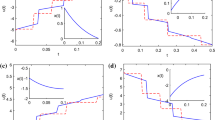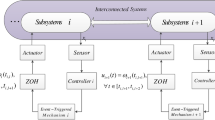Abstract
When dealing with microprocessors with limited resources and networks with limited bandwidth, the research of event triggering technology becomes more and more important. In order to save communication resources, this paper is concerned with the event-triggered control problem for a class of p-normal uncertain nonlinear systems with unknown growth rate. At first, an event-triggered controller is designed for the nominal system by adding a power integrator technique. Then, a novel dynamic gain is introduced into the proposed event-triggered controller to render lower-triangular uncertain nonlinear systems globally asymptotically stable. At the same time, Zeno phenomenon is excluded. Finally, the proposed method is extended to event-triggered control of p-normal upper-triangular uncertain nonlinear systems. A practical circuit system and a numerical simulation are given to illustrate the effectiveness of the proposed method.








Similar content being viewed by others
Data availability
Data sharing is not applicable to this article as no datasets were generated or analyzed during the current study.
References
Khalil, H.: Nonlinear Systems, 3rd edn. Prentice-Hall, New Jersey (2002)
Isidori, A.: Nonlinear Control Systems. Springer, Berlin (1995)
Marino, R., Tomei, P.: Nonlinear Control Design. Prentice-Hall, New Jersey (1995)
Krstic, M., Kanellakopoulos, I., Kokotovic, P.: Nonlinear and Adaptive Control Design. Wiley, New Jersey (1995)
Mazenc, F., Praly, L., Dayawansa, W.: Global stabilization by output feedback: examples and counterexamples. Syst. Control Lett. 23(2), 119–125 (1994)
Tsinias, J.: A theorem on global stabilization of nonlinear systems by linear feedback. Syst. Control Lett. 17(5), 357–362 (1991)
Gauthier, J., Hammouri, H., Othman, S.: A simple observer for nonlinear systems applications to bioreactors. IEEE Trans. Autom. Control 37(6), 875–880 (1992)
Chen, Z., Huang, J.: Global output feedback stabilization for uncertain nonlinear systems with output dependent incremental rate. In: Proceedings of the 2004 American Control Conference, pp. 3047–3052 (2004)
Qian, C.: A homogeneous domination approach for global output stabilization of a class of nonlinear systems. In: Proceedings of the 2005 American Control Conference, pp. 4708–4715 (2005)
Salehi, S., Shahrokhi, M.: Adaptive output feedback tracking controller for a class of uncertain strict feedback nonlinear systems in the absence of state measurements. Int. J. Syst. Sci. 43(2), 201–210 (2012)
Lei, H., Lin, W.: Universal output feedback control of nonlinear systems with unknown growth rate. Automatica 42(10), 1783–1789 (2006)
Liang, L., Yan, X., Shen, T.: Global output-feedback adaptive stabilization for uncertain nonlinear systems with polynomial growth nonlinearities. Syst. Control Lett. 165, 105269 (2022)
Zhai, J., Liu, C.: Global dynamic output feedback stabilization for a class of high-order nonlinear systems. Int. J. Robust Nonlinear Control 32(3), 1828–1843 (2022)
Astrom, K., Bernhardsson, B.: Comparison of periodic and event based sampling for first-order stochastic systems. In: Proceedings of the 14th IFAC World Congress, pp. 5006–5011 (1999)
Arzen, K.: A simple event-based PID controller. In: Proceedings of the 14th IFAC World Congress, pp. 8687–8692 (1999)
Tabuada, P.: Event-triggered real-time scheduling of stabilizing control tasks. IEEE Trans. Autom. Control 52(9), 1680–1685 (2007)
Girard, A.: Dynamic triggering mechanisms for event-triggered control. IEEE Trans. Autom. Control 60(7), 1992–1997 (2015)
Yang, P., Chen, X., Zhao, X., Song, J.: Observer-based event-triggered tracking control for large-scale high order nonlinear uncertain systems. Nonlinear Dyn. 105, 3299–3321 (2021)
Xing, L., Wen, C., Liu, Z., Su, H., Cai, J.: Event-triggered output feedback control for a class of uncertain nonlinear systems. IEEE Trans. Autom. Control 64(1), 290–297 (2019)
Wang, Y., Zheng, W., Zhang, H.: Dynamic event-based control of nonlinear stochastic systems. IEEE Trans. Autom. Control 62(12), 6544–6551 (2017)
Cheng, Y., Zhang, J., Du, H., Wen, G., Lin, X.: Global event-triggered output feedback stabilization of a class of nonlinear systems. IEEE Trans. Syst. Man Cybern. Syst. 51(7), 4040–4047 (2021)
Ling, S., Wang, H., Liu, P.: Fixed-time adaptive event-triggered tracking control of uncertain nonlinear systems. Nonlinear Dyn. 100, 3381–3397 (2020)
Wang, W., Li, Y.: Observer-based event-triggered adaptive fuzzy control for leader-following consensus of nonlinear strict-feedback systems. IEEE Trans. Cybern. 51(4), 2131–2141 (2021)
Shu, F., Zhai, J.: Dynamic event-triggered tracking control for a class of p-normal nonlinear systems. IEEE Trans. Circuits Syst. I Reg. Pap. 68(2), 808–817 (2021)
Shu, F., Zhai, J.: Adaptive event-triggered control for switched p-normal nonlinear systems via output feedback. IEEE Trans. Cybern. 52(7), 7060–7068 (2022)
Chang, Y., Zhang, X., Liu, S., Kong, L.: Event-triggered output feedback control for feedforward nonlinear systems with unknown measurement sensitivity. Nonlinear Dyn. 104, 3781–3791 (2021)
Deng, C., Wen, C., Wang, W., Li, X., Yue, D.: Distributed adaptive tracking control for high-order nonlinear multiagent systems over event-triggered communication. IEEE Trans. Autom. Control 68(2), 1176–1183 (2023)
Li, F., Liu, Y.: Adaptive event-triggered output-feedback controller for uncertain nonlinear systems. Automatica 117, 109006 (2020)
Koo, M., Choi, H., Lim, J.: Global regulation of a class of uncertain nonlinear systems by switching adaptive controller. IEEE Trans. Autom. Control 55(12), 2822–2827 (2010)
Bacciotti, A., Rosier, L.: Liapunov Functions and Stability in Control Theory. Springer, Berlin (2005)
Polendo, J., Qian, C.: A generalized homogeneous domination approach for global stabilization of inherently nonlinear systems via output feedback. Int. J. Robust Nonlinear Control 17(7), 605–629 (2007)
Xing, L., Wen, C., Liu, Z., Su, H., Cai, J.: Adaptive compensation for actuator failures with event-triggered input. Automatica 85, 129–136 (2017)
Yu, H., Chen, T.: On Zeno behavior in event-triggered finite-time consensus of multiagent systems. IEEE Trans. Autom. Control 66(10), 4700–4714 (2021)
Tabuada, P.: Event-triggered real-time scheduling of stabilizing control tasks. IEEE Trans. Autom. Control 52(9), 1680–1685 (2007)
Lander, C.: Power Electronics. McGraw-Hill, New York (1987)
Zhai, J.: Adaptive finite-time control for a class of p-normal nonlinear systems. IEEE Trans. Circuits Syst. II Exp. Brief 70(2), 705–709 (2023)
Acknowledgements
This work is supported in part by National Natural Science Foundation of China (62373096) and Natural Science Foundation of Jiangsu Province (BK20211162)
Funding
The authors have not disclosed any funding.
Author information
Authors and Affiliations
Corresponding author
Ethics declarations
Conflict of interest
The authors declare that there is no conflict of interest regarding the publication of this paper.
Additional information
Publisher's Note
Springer Nature remains neutral with regard to jurisdictional claims in published maps and institutional affiliations.
Appendix
Appendix
In this section, a generic constant c is used to represent some positive constant values. It may be different in different places.
Proof of Proposition 1:
From the construction of \(W_k\), one has
From (10) and using Young’s inequality, it can be seen that
Substituting (A2) into (A1) and using Young’s inequality, one has
with a constant \({\hat{c}}_1>0\).
Proof of Proposition 2:
By Lemma 3, one has
From (10), one has
If \(\tau >0\), then \(\frac{r_{i-1}}{r_ip_{i-1}}=\frac{r_{i-1}}{r_{i-1}+\tau }<1\). Then, we have
If \(\tau \le 0\), then \(\frac{r_{i-1}}{r_ip_{i-1}}=\frac{r_{i-1}}{r_{i-1}+\tau }\ge 1\). By Lemma 3, one has
From the above two cases, one has
where \(\alpha _i>0\) and \(g_i\) is a continuous function of \(l_{i-1}\) with \(g_2(\cdot )=0\).
Proof of Proposition 3:
From the definition of \(e_i\) and using Lemma 3, one has
where \(m_i=2^{1-\rho _i/p_{i-1}}\).
Proof of Proposition 4:
From the definitions of \(\rho _i\) and \(r_i\), one has \(r_i\rho _i/r_{i-1}>1\). By Lemma 3, from (21) one has
From the definition of \(e_i\) and (10), one has
Substituting (A11) into (A10) and using Young’s inequality, one has
where \(h_i(\cdot )\) is a continuous function of \(l_{i-1}\). It should be pointed out that \({\hat{x}}_i^{\rho _i}-\zeta _i^{r_i\rho _i/r_{i-1}}=0\) for \(i=2\).
Proof of Proposition 5:
From (22) and the definition of \(e_i\), one has
From the definition of \(e_{n-1}\), one has
If \(\tau \ge 0\), then \(\frac{r_{n-1}}{r_np_{n-1}}=\frac{r_{n-1}}{r_{n-1}+\tau }\le 1\). By Lemma 3, one has
If \(\tau < 0\), then \(\frac{r_{n-1}}{r_np_{n-1}}=\frac{r_{n-1}}{r_{n-1}+\tau }>1\). From (10) and Lemma 3, one has
Using Young’s inequality and the above inequalities, one has
where \({\bar{\alpha }}, c_1\) are constants and \(g_n\) is a continuous function of \(l_{n-1}\).
Proof of Proposition 6:
From (33), one has
where the last relation is obtained by \(\xi _n^\frac{2\mu -\tau -r_{n}}{\alpha }x_{n+1}^{*}\le 0\) and \(\frac{1+\delta _0 L^{-1}}{1+b_1(t)\delta _0 L^{-1}}-1\ge 0\).
Now, we estimate the first term of (A19).
From (10), one has \(|x_i^{{\alpha }/{r_i}}|\le c(|\xi _i|+|\xi _{i-1}|)\). By Lemma 3, we have
Substituting (A21) into (A20) yields
where \({\tilde{\alpha }}>0\) is a constant.
By using Young’s inequality, one has
where \(c_2>0\) is a constant.
Substituting (A22) and (A23) into (A19), one has
Rights and permissions
Springer Nature or its licensor (e.g. a society or other partner) holds exclusive rights to this article under a publishing agreement with the author(s) or other rightsholder(s); author self-archiving of the accepted manuscript version of this article is solely governed by the terms of such publishing agreement and applicable law.
About this article
Cite this article
Zhai, J. Event-triggered control for p-normal uncertain nonlinear systems. Nonlinear Dyn 112, 3661–3677 (2024). https://doi.org/10.1007/s11071-023-09220-0
Received:
Accepted:
Published:
Issue Date:
DOI: https://doi.org/10.1007/s11071-023-09220-0




